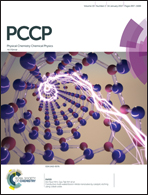Water aggregation and dissociation on the ZnO(10![[1 with combining macron]](https://www.rsc.org/images/entities/char_0031_0304.gif) 0) surface†
0) surface†
Abstract
A comprehensive search for stable structures in the low coverage regime (0–1 ML) and at 2 ML and 3 ML using DFT revealed several new aggregation states of water on the non-polar ZnO(10![[1 with combining macron]](https://www.rsc.org/images/entities/char_0031_0304.gif) 0) surface. Ladder-like structures consisting of half-dissociated dimers, arranged side-by-side along the polar axis, constitute the most stable aggregate at low coverages (≤1 ML) with a binding energy exceeding that of the monolayer. At coverages beyond the monolayer – a regime that has hardly been studied previously – a novel type of structure with a continuous honeycomb-like 2D network of hydrogen bonds was discovered, where each surface oxygen atom is coordinated by additional H-bonding water molecules. This flat double-monolayer has a relatively high adsorption energy, every zinc and oxygen atom is 4-fold coordinated and every hydrogen atom is engaged in a hydrogen bond. Hence this honeycomb double monolayer offers no H-bond donor or acceptor sites for further growth of the water film. At 3 ML coverage, the interface restructures forming a contact layer of half-dissociated water dimers and a liquid-like overlayer of water attached by hydrogen bonds. The structures and their adsorption energies are analysed to understand the driving forces for aggregation and dissociation of water on the surface. We apply a decomposition scheme based on a Born–Haber cycle, discussing difficulties that may occur in applying such an analysis to the adsorption of dissociated molecules and point out alternatives to circumvent the bias against severely stretched bonds. Water aggregation on the ZnO surface is favoured by direct water–water interactions including H-bonds and dipole–dipole interactions and surface- or adsorption-mediated interactions including enhanced water–surface interactions and reduced relaxations of the water molecules and surface. While dissociation of isolated adsorbed molecules is unfavourable, partial or even full dissociation is preferred for aggregates. Nevertheless, direct water–water interactions change very little in the dissociation reaction. Dissociation is governed by a subtle balance between strongly enhanced water–surface interactions and the large energies required for the geometric changes of the water molecule(s) and the surface. Our conclusions are discussed on the background of the current knowledge on water adsorption at metals and non-metallic surfaces.
0) surface. Ladder-like structures consisting of half-dissociated dimers, arranged side-by-side along the polar axis, constitute the most stable aggregate at low coverages (≤1 ML) with a binding energy exceeding that of the monolayer. At coverages beyond the monolayer – a regime that has hardly been studied previously – a novel type of structure with a continuous honeycomb-like 2D network of hydrogen bonds was discovered, where each surface oxygen atom is coordinated by additional H-bonding water molecules. This flat double-monolayer has a relatively high adsorption energy, every zinc and oxygen atom is 4-fold coordinated and every hydrogen atom is engaged in a hydrogen bond. Hence this honeycomb double monolayer offers no H-bond donor or acceptor sites for further growth of the water film. At 3 ML coverage, the interface restructures forming a contact layer of half-dissociated water dimers and a liquid-like overlayer of water attached by hydrogen bonds. The structures and their adsorption energies are analysed to understand the driving forces for aggregation and dissociation of water on the surface. We apply a decomposition scheme based on a Born–Haber cycle, discussing difficulties that may occur in applying such an analysis to the adsorption of dissociated molecules and point out alternatives to circumvent the bias against severely stretched bonds. Water aggregation on the ZnO surface is favoured by direct water–water interactions including H-bonds and dipole–dipole interactions and surface- or adsorption-mediated interactions including enhanced water–surface interactions and reduced relaxations of the water molecules and surface. While dissociation of isolated adsorbed molecules is unfavourable, partial or even full dissociation is preferred for aggregates. Nevertheless, direct water–water interactions change very little in the dissociation reaction. Dissociation is governed by a subtle balance between strongly enhanced water–surface interactions and the large energies required for the geometric changes of the water molecule(s) and the surface. Our conclusions are discussed on the background of the current knowledge on water adsorption at metals and non-metallic surfaces.
![Graphical abstract: Water aggregation and dissociation on the ZnO(10 [[1 with combining macron]] 0) surface](/en/Image/Get?imageInfo.ImageType=GA&imageInfo.ImageIdentifier.ManuscriptID=C6CP07516A&imageInfo.ImageIdentifier.Year=2017)


 Please wait while we load your content...
Please wait while we load your content...
![[1 with combining macron]](https://www.rsc.org/images/entities/h2_char_0031_0304.gif) 0) surface
0) surface